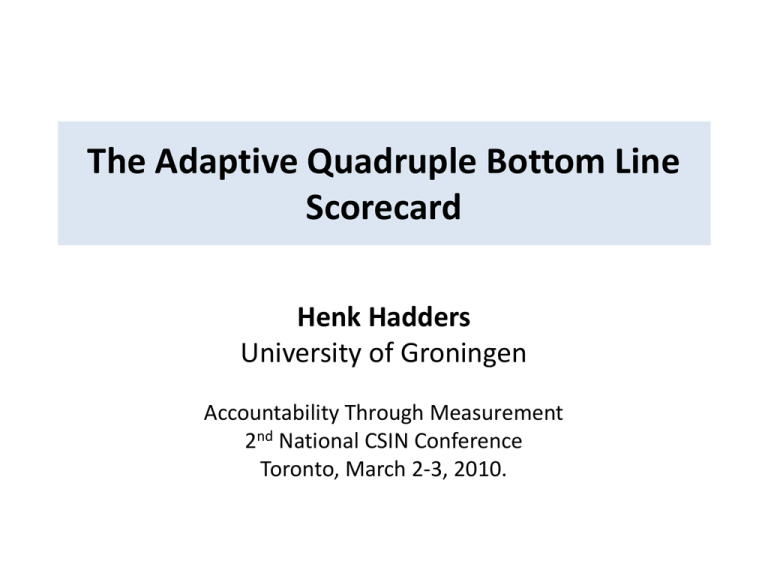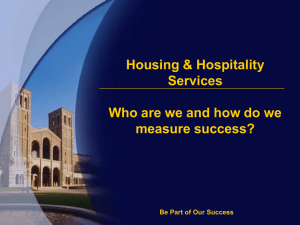Henk Hadders
advertisement

The Adaptive Quadruple Bottom Line Scorecard Henk Hadders University of Groningen Accountability Through Measurement 2nd National CSIN Conference Toronto, March 2-3, 2010. Intro 1. Organizational Sustainability 2. A new Strategic Performance Scorecard: - The Adaptive Quadruple Bottom Line Scorecard (AQBLSC) 3. A new Sustainability Measurement and Reporting Tool: - Capitals-based approach - Context-based sustainability & Context-based metrics - Quotients-based sustainability approach A Reference Model Knowledge Integration Surviving Knowledge Claims Knowledge Claim Evaluation Create new Knowledge Claims needed for Problem solution Duties and obligations to stakeholders regarding impact on vital capitals Social Contract (Norm) Stakeholders Actual impact Knowledge on Adaptation Knowledge Production Organizational Operations Actual Problem Impact on Detection and Knowledge gaps Interaction Vital Forms of Capital Natural ,Human, Social, Constructed Appropriations Affective, Evaluative Response and behavior Well-Being Internal and External stakeholders Create flow of goods and services needed and used for Reactive Learning “downloading” Mental models Thinking Reenacting habits Doing All learning integrates thinking and doing. In reactive learning, thinking is governed by established mental models and doing is governed by established habits of action Adopted from Senge, P. et al : Presence (2004) Deeper Levels of (Creative) Learning Thinking Increasing awareness of the whole Action that increasingly serves the whole Doing Deeper levels of learning create increasing awareness of the larger whole – both as it is and as it is evolving– and actions that increasingly become part of creating alternative futures. Adopted from Senge, P. et al : Presence (2004) The Adaptive Maturity Model Thinking Increasing awareness of the whole Financial Metrics Balanced Scorecard Adaptive Scorecard AQBLSC Adopted from Joe Firestone (2006) Action that increasingly serves the whole Doing A different way of viewing organizational performance scorecards • A life cycle approach enables managers to… – Design more complex scorecards to account for more variables, and – Assess more types of organizational performance • • • • • • • • Financial Environmental Social Economic Learning Knowledge Organizational Intelligence Organizational Adaptation What is the Adaptive Quadruple Bottom Line Scorecard ? • The AQBLSC is a tool for measuring business performance that not only considers standard metrics, such as financial, customer, business process, and employee development – it also evaluates a firm’s 1. Organizational Learning and Intelligence 1. Routine learning processes 2. Deeper creative learning processes 2. Social Responsibility 3. Sustainability 4. Adaptive Capacity Major Benefits of the Adaptive Quadruple Bottom Line Scorecard The AQBLSC…… • Balances between internal and external impacts of the organization • Incorporates a management evaluation perspective that provides a basis for evaluating the quality of management processes used • Provides a conceptual foundation that can enable more sophisticated formal modeling of measures, and simulation of strategy dynamics • Offers greater applicability to account for the many ways in which organizational complexity impacts performance • Builds a foundation for formulating more sophisticated business strategies • Adopts a broad-view systems approach that offers a high probability of achieving organizational sustainability and adaptability The AQBLSC Business Processing (BP) and Management (BM) Operational Performance Measures Doing (BP) Outcome Financial Bottom Line Environmental Bottom Line Social Bottom Line Economic Bottom Line Internal Stakeholders External Stakeholders Internal Stakeholders External Stakeholders Internal Stakeholders External Stakeholders Impact Managing (BM) Outcome Impact Knowledge Processing (KP) and Management (KM) Intelligence Performance Measures Doing (KP) Outcome Impact Managing (KM) Outcome Impact Business Processing (BP) and Management (BM) Knowledge Processing (KP) and Management (KM) Operational Performance Measures Doing (BP) Outcome Impact Managing (BM) Outcome Impact Intelligence Performance Measures Doing (KP) Outcome Impact Financial Bottom Line Environmental Bottom Line TBL Social Bottom Line Economic Bottom Line Internal Stakeholders External Stakeholders Internal Stakeholders External Stakeholders Internal Stakeholders External Stakeholders Advocating for non-financial impact measurement, using • Capitals-Based Theory • Context-Based Metrics (CBMs) • Ecological and Social Footprints with Sustainability Quotient Method Managing (KM) Outcome Impact Non-Financial Capitals and Well-Being Natural Capital Anthro Capital Available Flows of Beneficial Goods and Services Appropriations by Individuals and Collectives This is the capitals-based theory of Sustainability to which we subscribe! Resulting Levels of Individual and Collective Well-Being The 4 Bottom Lines and their Capitals Area of Impact ANTHRO Capital Monetary Capital Bottom Line Financial Bottom Line Environmental Bottom Line Social Bottom Line Economic Bottom Line Internal Stakeholders External Stakeholders Internal Stakeholders External Stakeholders Internal Stakeholders External Stakeholders Natural Capital Human Capital Social Capital Constructed Capital Adding Organizations to the Mix management interventions and impacts on organizational activity organizational contributions to supplies of vital capital (pos.& neg.) Positive & Organizational activity neg. impacts indicators and metrics indicators and metrics quality and size of stocks of capital Stocks of Vital Capital indicators and metrics quality and volume of flows from capital Positive & neg. impacts indicators and metrics basic needs being met ? (yes/no) Human Well-being indicators and metrics …..and mapping indicators and metrics to this causal theory of human well-being Adopted from McElroy (2009) Definition of CBMs: Measures of sustainability performance that express impacts on social and/or environmental resources in the world, relative to what such impacts ought to be in order to ensure human well-being – Grounded in the context of actual social and/or environmental conditions in the world – Literal measures (absolute, not relative) of sustainability performance An Example: Water Use (w/o context) Fortune 500 Company’s Annual Water Use Mark W. McElroy, 2008 An Example: Water Use (with context) Fortune 500 Company’s Annual Water Use Mark W. McElroy, 2008 CBMs Take Form of Quotients Sustainability Performance Scoring Conventions Mark W. McElroy, 2008 A = N Actual impacts on vital resources Normative impacts on vital resources For environmental areas, scores of < 1.0 = Sustainable For social areas, scores of > 1.0 = Sustainable I thank my US Friends • Joe Firestone PhD, CEO of Knowledge Management Consortium International: eisai@comcast.net – the Adaptive Scorecard • Steve Cavaleri PhD, Professor Connecticut State University: cavaleri@ccsu.edu – System Dynamics and Modeling • Mark W. McElroy PhD, CEO of the Center for Sustainable Innovation & Director of Research at Deloitte’s Center for Sustainable Performance in Waltham, Mass, : mmcelroy@vermontel.net – the Social Footprint and the Quotient approach to sustainability and Thank You! For more information, contact us at Henk Hadders University of Groningen henk.hadders@home.nl








